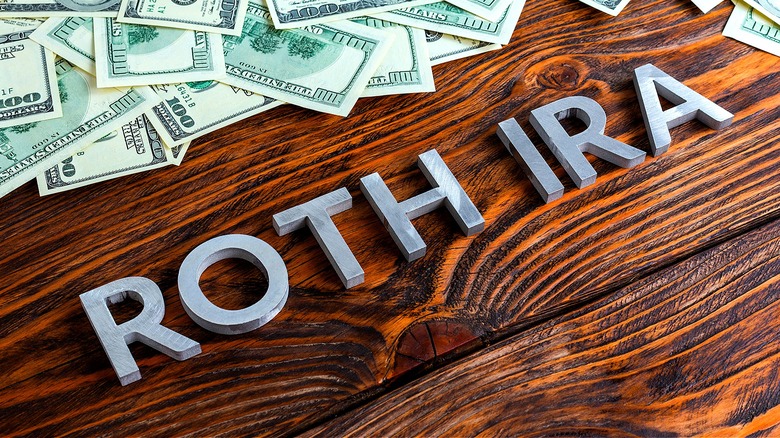Here's How To Figure Out If A 401(k) Or A Roth IRA Is Right For You
When it comes to saving for retirement, it can sometimes be a financial goal that — while definitely important — can seem less urgent than all the other expenses you need to take care of in the present. However, once you begin and start to see your retirement account(s) grow, it can be a great source of financial comfort and security, as you start to feel better about your future. With retirement savings, one decision you'll eventually face is what kind of retirement account you should open. Specifically, if the choice is between a 401(k) and a Roth IRA, which is the right one for you?
For such a decision, the presumption is that your current employer offers a 401(k) plan for you to participate in. If you had unlimited resources, the answer to this question would be simple: Choose and invest in both, to the maximum. However, most Americans don't have this luxury, and for every person, the decision of a 401(k) versus a Roth IRA will be particular to their financial situation and goals. Factors everyone working within a strict household budget should consider, however, include how the retirement plan is taxed, contribution limits, employer matching, and future withdrawals.
With this said, choosing both retirement accounts can still be an option for you, even with limited money to contribute to each plan each year. The key is 1) how much you're able to contribute and 2) which account you should contribute to first, which will largely depend on if your employer offers matching contributions.
Taxes
Probably the biggest difference between a 401(k) plan and a Roth IRA is taxes. In short, a 401(k) is funded with pretax dollars, and a Roth IRA is funded with after-tax money. Further, contributions to a 401(k) are deducted from your gross income come tax season, while Roth IRA contributions are not deductible.
The tax implications go beyond the present, though. With a 401(k), all the money in the retirement account is subject to tax once you begin to make withdrawals. A Roth IRA account, meanwhile, is a tax-advantaged account, and earnings from the account are tax-free so long as withdrawals are made after age 59 ½ (and the account has aged at least five years). Financial experts note that paying taxes in the present on a Roth IRA can prove especially advantageous for anyone who believes that their marginal tax rate will be higher once they reach age 59 ½.
Contribution limits
When deciding if a 401(k) or a Roth IRA is better for you, the contribution limits of each plan may help you choose. You can contribute far more every year to a 401(k) than an IRA. For 2024, the IRS announced increases of $500 for both 401(k) and IRA contributions, resulting in a $23,000 limit for 401(k) plans and a $7,000 limit for IRAs — both traditional and Roth. For 401(k)s, the $23,000 limit doesn't include employer matches. This said, the total contribution limit for employee and employer contributions to a 401(k) plan combined is $69,000.
Further, if you're over 50 years of age and are perhaps hoping to make up for years where you were unable to contribute more to your retirement savings, or perhaps didn't have a 401(k) option at your previous jobs, then you could contribute a bit more to either a 401(k) or Roth IRA. For 401(k)s, you can contribute $7,500 more in make-up contributions (on top of the $69,000 total limit). For a Roth IRA, you can add $1,000 more in after-tax dollars to your account.
Employer matching
According to a 2023 CNBC/SurveyMonkey survey, 57% of the 4,000 U.S. adults surveyed said they contributed to their company's 401(k) plan, with respondents aged 35-64 being the group most likely to participate at 63%. As for contribution amounts, 46% said they contributed as much as they could afford, while 11% said they contributed up to the IRS limit, and 24% said they contributed "as much as my employer matches."
As financial experts will tell you, the employer match is free money, and one 401(k) mistake many make is not contributing up to the employer match (at least). While the amount a company matches varies, a common amount is dollar-for-dollar up to 3% of an employee's salary, or 50% up to 6% of an employee's salary. So, for instance, if your salary is $60,000 a year and you contribute 3% to your 401(k), that's $1,800, but because your employer matches 100% up to 3%, that's another $1,800 for your retirement savings. If you contributed 6%, or $3,600, and your employer matched it at 50%, it similarly would come to $1,800 more in free money.
One way to invest in both a 401(k) and a Roth IRA is to take advantage of your employer's match, then work toward funding a Roth IRA. In this way, you won't miss out on the free money that your company is offering, but you also can take advantage of the after-tax element of a Roth IRA. Since the IRA contribution limit is a lot less than a 401(k), you can always return to funding your 401(k) once you max out your IRA for the year.
Income eligibility
While participation in a 401(k) requires you be employed by a company that offers the retirement benefit, there is no income eligibility restriction. No matter how much you make, you can participate in your company's 401(k). For Roth IRAs, however, eligibility begins to phase out once your income reaches a certain threshold — based on your filing status. If you're a single filer, you're eligible for a Roth IRA in 2024 if your modified adjusted gross income, or MAGI, doesn't exceed $153,000. For married couples filing jointly, the threshold is $240,000.
Further, with regard to contributions, with a Roth IRA, you can withdraw contributions — not the account's earnings — tax-free at any time and at any age. You won't be assessed a penalty so long as the account is five years or older. If you do withdraw contributions from your Roth IRA, note that you don't need to report this as income for the year, as you've already paid taxes on it.
Required minimum distributions
Speaking of account withdrawals, another difference between a 401(k) and a Roth IRA concerns required minimum distributions, or RMDs. An RMD is the minimum amount you must withdraw from your retirement account; this amount is determined by dividing the balance of the account on December 31 of the year before by the "life expectancy factor that the IRS publishes in Tables in Publication 590-B."
If you don't withdraw the correct amount, you could be subject to a 25% penalty. For example, if your 401(k) had a balance of $500,000 to end the previous year, and you're 73 years of age, your life expectancy factor is 26.5, so your RMD would be $18,868. If you fail to withdraw this RMD by the deadline, then you could be penalized $4,717, or 25% of $18,868. Note, the life expectancy factor goes down every year.
As for Roth IRAs, an account owner isn't subject to RMD rules until death; you don't have to ever make a withdrawal on your account if your don't want to. However, beneficiaries who inherit a Roth IRA will need to abide by the rules, which means they'll need to begin taking distributions by the last day of the year if the account holder had already reached age 73. If the account holder died before age 73, then the beneficiaries can delay taking any RMDs until what would have been the account holder's 73rd year.





